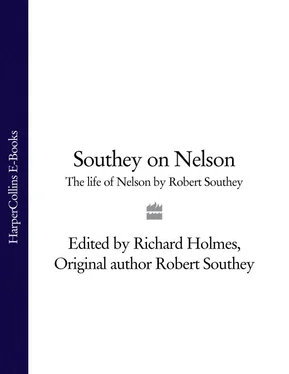By 1813 the immediate cult of Nelson was fading, and Wellington’s star was rising. So at first the book found its general readers slowly, but steadily enough. It was published in the same year as Pride and Prejudice, and Jane Austen herself said she was bored with books about Nelson unless they mentioned her brother. The first edition of 3,000 copies (quite large for its day) was reprinted later that summer. A third edition appeared in 1814, and after a long gap, a fourth edition in 1827, largely to incorporate the new Lady Hamilton materials. This was the last that Southey seriously revised.
However the fortunes of the biography, and the perceptions of the kind of book it was, changed radically in 1830. This followed a full-scale retrospective of all Southey’s work by Thomas Macaulay in the Edinburgh Review for January, 1830. Macaulay singled out Nelson as the finest thing Southey had ever written, destined to endure longer than any of his poetry, and to be read more widely than any of his multi-volume histories. But in doing this, he overlooked all the controversial themes Southey had so carefully explored, and ignored the complex Romantic portrait he had achieved of Nelson.
Instead Macaulay relaunched the biography as a gripping adventure story of a Boy’s Own hero: the literary equivalent of a patriotic Victorian pub sign. Given all Southey’s initial doubts, and his subsequent meticulous researches, his anxieties about Nelson and Lady Hamilton, and his concerns about Naples, it was a supremely ironic outcome. ‘No writer, perhaps, ever lived, whose talents so precisely qualified him to write the history of the great naval warrior,’ boomed Macaulay. There were no fine riddles of the human heart to read–no theories to found–no hidden causes to develop–no remote consequences to predict. The character of the hero lay on the surface. The exploits were brilliant and picturesque…it was an exact hit between wind and water.’
After this brassy endorsement, the book quickly became a bestseller, and then a Victorian classic. The young Queen herself was reported to have adored the Nelson story–as a girl. New editions appeared in 1830,1831, and in 1840, the year of Southey’s own death. There were more than a hundred editions by the end of the century. In America it was issued as a standard manual to all naval cadets, rather as John Murray had originally foreseen.
At the same time Victorian naval scholars, starting with the great Sir Harris Nicolas and his mighty edition of Nelson’s Dispatches (1844-6), began firmly to set Southey aside as a children’s book, no longer relevant to serious readers. This marginalising work was completed by Professor Geoffrey Callender’s highly critical annotated edition of 1922, which page by page, and footnote by footnote, picked minute holes in Southey’s understanding of everything from flags and knots, to navigation and international diplomacy. Yet strangely enough, even Cal-lender ended by observing that ‘the Nelson whom we know today is almost as truly Southey’s as Henry the V and Richard the III are Shakespeare’s’.
To his great surprise, the biography immediately made Southey’s own career. Its patriotism caught a public mood, and he was offered the Poet Laureateship that autumn (on the generous recommendation of Walter Scott). His position with his publishers and the Quarterly Review was assured, and Murray later urged him to write Lives of two other notable warriors, first the Duke of Wellington, and then the Duke of Marlborough. He wrote extended essays on both for the Quarterly, as he had with Nelson; but finally–and perhaps wisely–he turned down both ideas—in Wellington’s case with the pointed comment that biographies of living persons were impertinent. He did however write an enormous, erudite and worthy three volume History of the Peninsular War (1823—1832), which has sunk without trace.
To the end of his career, Southey remained intrigued by the more introspective aspects of the form, and what biography could tell us about an inner life. He later wrote long and thoughtful Lives of John Wesley (1820), John Bunyan (1830), and the poet William Cowper (1835). They have striking passages, such as the moment when the boy Wesley is dramatically–and symbolically–saved from a house fire, ‘a brand plucked from the burning’. Yet none of them have the narrative flair and the instinctive passion of his portrait of Nelson, whom he once described in an inspired moment truly worthy of a Poet Laureate, as ‘the hero, the darling hero of England’.
1758 (29 September) Horatio Nelson born at Burnham Thorpe, Norfolk
1774 Robert Southey born in Bristol
1771 Nelson joins the Royal Navy as a midshipman at Chatham
1773 Nelson sails to the Arctic
1777 Nelson sails to the West Indies
1787 Nelson marries Mrs Fanny Nisbet on Nevis, in the British Caribbean
1788 Nelson retires to Norfolk on half-pay
1792 Southey goes to Oxford University
1793 (January) Nelson given command of HMS Agamemnon (September) Nelson first meets Emma Hamilton at Naples
1794 (July) Nelson loses sight of right eye while besieging Calvi, Corsica
1795 Southey lectures with Coleridge in Bristol
1796 Southey sails to Spain
1797 (February) Nelson ‘breaks the line’ at the Battle of Cape St Vincent (July) Nelson loses right arm at Santa Cruz
1798 (August) Nelson wins the Battle of the Nile (Aboukir Bay) Southey publishes his ballads, ‘The Inchscape Rock’ and ‘The Battle of Blenheim’
1799 Nelson in Naples with Emma Hamilton Execution of Caraccioli, and Neapolitan ‘rebels’
1800 Nelson separates from Lady Nelson
1801 (April) Nelson disobeys orders at the Battle of Copenhagen
Nelson’s illegitimate daughter, Horatia, born Southey publishes Thalaba, the Destroyer
1803 (June) Nelson takes command of the Mediterranean fleet
Southey moves to the Lake District
1805 (August) Nelson’s last summer in England with Emma and Horatia
(15 October) Nelson dies at the Battle of Trafalgar
1810 Southey begins publishing his History of Brazil Southey reviews several Nelson biographies for The Quarterly
1813 Southey publishes The Life of Nelson Southey appointed Poet Laureate
1815 Emma Hamilton dies in Calais
1820 Southey publishes The Life of John Wesley
1833 Southey publishes his Lives of the British Admirals
1843 Southey dies in Keswick, Cumberland
Many lives of Nelson have been written: one is yet wanting, clear and concise enough to become a manual for the young sailor, which he may carry about with him till he has treasured up the example in his memory and in his heart. In attempting such a work I shall write the eulogy of our great Naval Hero; for the best eulogy of NELSON is the faithful history of his actions; the best history, that which shall relate them most perspicuously.
ROBERT SOUTHEY
THE LIFE OF NELSON
Конец ознакомительного фрагмента.
Текст предоставлен ООО «ЛитРес».
Прочитайте эту книгу целиком, купив полную легальную версию на ЛитРес.
Безопасно оплатить книгу можно банковской картой Visa, MasterCard, Maestro, со счета мобильного телефона, с платежного терминала, в салоне МТС или Связной, через PayPal, WebMoney, Яндекс.Деньги, QIWI Кошелек, бонусными картами или другим удобным Вам способом.












